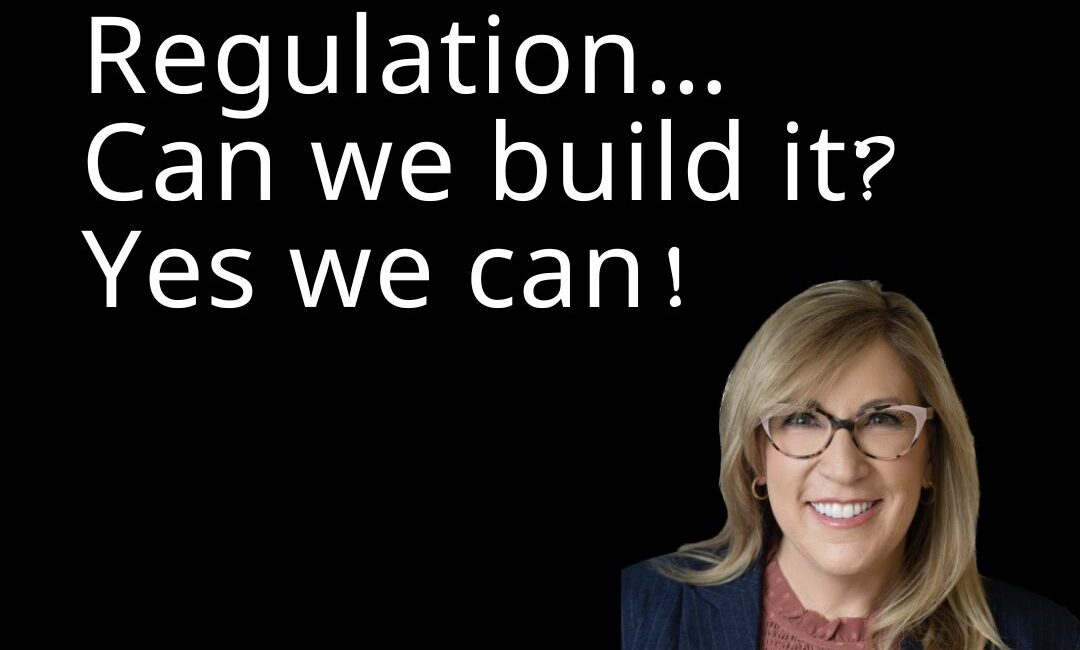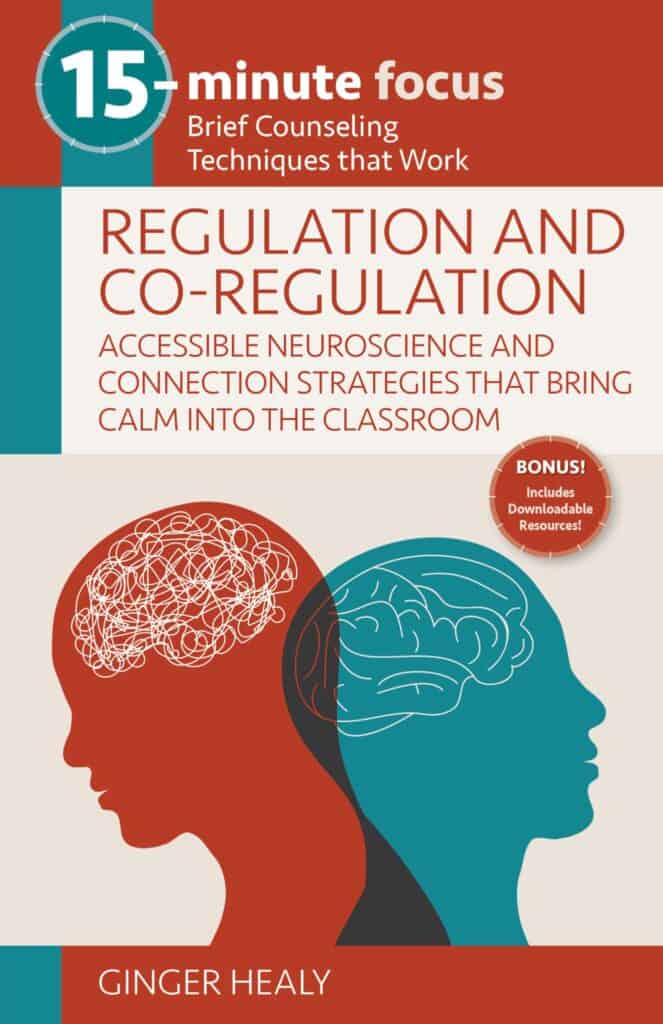I am so excited to welcome Ginger Healy to the BraveBrains blog to share some support for that ever-elusive skill: self-regulation. Ginger has been a friend and colleague for years. She is currently the program director for the Attachment and Trauma Network where she co-anchors the podcast “Regulated & Relational” and speaks across the nation on trauma-informed schools, therapeutic parenting, and community engagement. She also gives great hugs!

Dysregulation
Dysregulation. The reality is that no one escapes it. Both students and teachers experience dysregulation every day. The problem is not in becoming dysregulated but in remaining dysregulated. The answer lies in positive co-regulating experiences that lead to self-regulation. Establishing self-regulation skills are critical for our optimal physical and emotional health, academic success, relationship satisfaction, and more.
Emotional regulation is a learned skill
Emotional regulation is a learned skill requiring practice and repetition in a predictable, responsive, supportive environment. Most importantly, it requires a regulated adult with whom a child can co-regulate. Not just any adult can support a child through co-regulation. A safe, committed, attuned, REGULATED adult is essential because a dysregulated adult CANNOT support the regulation of another.
When I teach educators how we can influence the development of self-regulation skills in students, I often break it down into a three-step process.
- Step 1: Adult Regulation. Model and maintain a regulated state and re-regulate self after slipping into dysregulation when co-regulating with a child.
- Step 2. Co-regulation. Engage in emotional and physical support practices to soothe and/or activate the nervous system of a child in order to change behavior and help them heal.
- Step 3. Actively teach self-regulation skills. Help scaffold and develop emotional regulation skills in the child so that they can continue to manage their emotions and behaviors when a safe adult is not present.
Can you guess which of the steps is most often reported to be the most challenging? Yup, it’s Step 1: adult regulation.
There are many reasons for this. Remaining poised and in control when a difficult behavior starts might not be challenging, but once that behavior ramps up it can be much trickier to stay regulated. Some days I can confidently say, “I got this!” but that is not every day! On those days when I am grasping at straws to keep myself steady enough to handle those dysregulated behaviors, I try to consider the following:
Know your triggers!
We as adults need to be aware of what activates our nervous system. It’s not fun being interrupted, spit on, kicked, yelled at, or stolen from. These behaviors can feel very personal and it makes sense that they would cause us to struggle to connect in a sensitive and attuned way when a child is communicating in these ways. It’s also important to note that what is triggering for one adult may not be for another. I remember working with a teacher who told me that she could handle anything but lying. I won’t say that I like it when a kid lies to me but for some reason, it just doesn’t push my buttons. I can see it for what it often is, a child who is worried about consequences or needs more attention/connection. It just doesn’t feel as personal to me as it often can for others.
But ignore me? Look away from me when I am talking? Yeah, that’s tough for me. I quickly get put on the defensive and want immediate compliance. Yet, for another adult that particular behavior may not bother them at all. So let’s be contemplative about our personal “tripwires” and work to alleviate them before they get activated.
Triggers aren’t always about the student’s behaviors in the classroom. Often, they arise when we are physically tired, hungry, or depleted from giving. We just aren’t as patient or nice when we are hangry and exhausted! How often do you skip breakfast because you are running late or get so caught up in work that lunch is an afterthought? This work is draining…can I get an amen? And when our students exhibit dysregulated feelings it can leave us empty and lacking the ability to give that needed compassion. Burnout anyone? Asking for a friend!
Use brain-aligned discipline.
It’s important to note that I am not advocating that these behaviors should be “let go” because they are triggering for us. I am saying that when we recognize that certain behaviors immediately pull us from regulation into dysregulation or we are emotionally and physically depleted, our response to behaviors can be compromised. Discipline indeed has a place in the regulation cycle, but it needs to be brain-based and appropriately timed. We have the power to strengthen our relationship with the student, guide self-regulation, and alleviate subsequent behaviors through a collaboration of consequences with the student.
“Name it to tame it”.
This is about noticing our innermost sensations and feelings that may have been ignored because we are overwhelmed and uncomfortable. Often, we don’t want to dig deep and discuss our feelings because we are ashamed of them or possibly unaware of what is happening internally. But when we sit with what is going on inside and express it out loud, it can soothe and regulate us! Dr. Dan Siegel, a brilliant professor of psychiatry and author teaches that honestly naming our emotional states re-activates the prefrontal cortex. It brings that higher-level processing back online.
This is important because during dysregulation we cannot access the part of our brain needed to solve problems! We need to be emotionally regulated to focus our attention, plan and prioritize, be self-aware, and be flexible in our thinking. Dr. Siegel also states that consciously labeling intense emotions signals the brain to send soothing neurotransmitters to our amygdala which in turn calms our body and mind, helping us feel more in control.
Simply put, saying it out loud makes us feel better. It regulates us! I know that often when I am struggling, the last thing I want to do is admit how I am feeling or that I made a mistake. The voice in my head is asking what is wrong with me because I should be able to handle this. However, this is exactly what our students need to hear us say. “I am having a hard time. I need a minute. I have made a mistake and to fix it and feel better I gotta push through this discomfort and talk about it.” This process is truly healing for us as adults in being able to get back in it when we have become dysregulated, and it’s an amazing example for learners. It gives them words, power, and a tool that helps build resilience!
This blog post is a form of “naming it.” I am hoping if you have feelings of stress, fear, or self-doubt (looking directly in the mirror here), that reading that you are not alone “tames” some of those feelings.
Look at behaviors through a new lens!
I can’t begin to tell you how powerful it was for me to learn that when my son ignored me, he was just trying to survive that moment. He actually wasn’t even ignoring me. He was dissociating, hoping my loud rant would be over soon. Once I discovered that, I felt so much empathy and compassion for him. I saw him and his behavior differently and my response to him totally changed. I could meet him where he was rather than demanding compliance for something that he could not do until he felt safe inside. I needed to identify his lagging skill, meet his needs and shift my expectations. He wasn’t being willfully disobedient, disrespectful, or manipulating me. He was struggling to survive in a body that constantly detected threats. He needed me to step back and see his struggle and the why underneath the behavior rather than trying to stop what was bothering me so that I felt better. The new lens helped me help him to feel better which also made me feel better.
“Power in the pause”
It’s all about responding instead of reacting. Look at the behavior from the outside, as if you were watching a movie. Take your emotion out of it rather than joining the chaos and adding to the intensity. Just as their dysregulation can be contagious so can your calm regulated state.
Sometimes this means stepping away and taking a physical break until you know you are ok to intervene. It’s perfectly ok to say, “I need a minute.” Go get a drink of water and use the restroom. It’s a good way to model to students how to pause and get control.
Some of you are rolling your eyes at me, I can feel it! Listen, I know that it is not always possible to take a physical break. Safety issues need to be taken into consideration. I get that. In those situations, if possible, close your eyes for a few seconds, take a deep breath (again modeling all this), and get perspective on the situation.
Repeat a healing mantra.
Say something to yourself that can shift you back into balance. Some of my favorites are:
- This is not about me. I can handle this.
- I am the right teacher for this student.
- I can try again, everyone flips their lid.
- I am my student’s safe space.
- I am in charge of my calm no matter how my students behave.
- I am not alone in this.
- My calm can be contagious.
And remember, this takes practice. We shouldn’t expect a student to be able to control their emotions easily and quickly and so we need to put that expectation back onto ourselves as well. The more we implement these techniques, the easier it will become. This leads me to the next strategy.
Let go of perfection.
We are all human, and we won’t always get it right. In fact, we shouldn’t always get it right. Perfection is impossible. Kids are going to make a lot of mistakes, and it will truly help them to know that they aren’t alone in making mistakes. We all need do-overs!
Reach out and ask for help.
Lastly, please reach out and ask for help. We need each other in this great work. Medical and therapeutic interventions are available and can help in deeper healing that may be required for both children and adults. Staying regulated can be messy and challenging, but it is also the regulation cycle’s first and most crucial step. The cycle can neither begin nor end unless the adult is emotionally regulated and able to re-regulate after inevitable disruptions.
You can do this! And if you mess up, give yourself a high-five for being human and try again.
By Ginger Healy, LCSW





